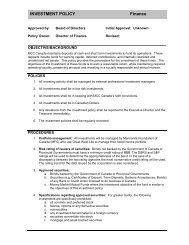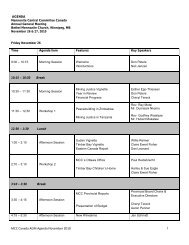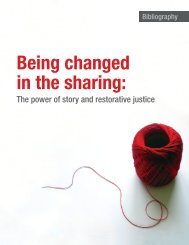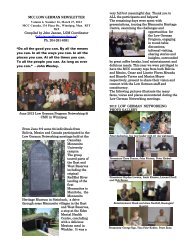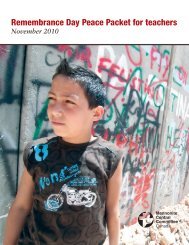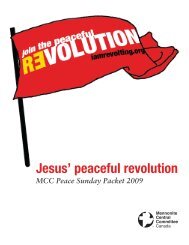Walking together: Healing and hope for Colombian refugees
Walking together: Healing and hope for Colombian refugees
Walking together: Healing and hope for Colombian refugees
You also want an ePaper? Increase the reach of your titles
YUMPU automatically turns print PDFs into web optimized ePapers that Google loves.
w a l k i n g<br />
t o g e t h e r<br />
21<br />
or no infrastructure. This has meant that illegal armed groups (insurgents <strong>and</strong> paramilitaries) can easily take<br />
over large territorial blocks.<br />
Colombia’s legal economic activity revolves around petroleum, coal, coffee, tropical fruits, flowers, textiles<br />
<strong>and</strong> leather, emeralds <strong>and</strong> sugar cane. Tragically, the monopoly of the <strong>Colombian</strong> elite over the country’s<br />
wealth has led to the creation of a high level of parallel illegal economic activity, first in the emerald trade,<br />
then marijuana <strong>and</strong> then, since the 1980s, cocaine <strong>and</strong> heroin. In the early 1990s, Colombia moved<br />
from not only being the world’s biggest “processor” of coca-to-cocaine, to also becoming the biggest<br />
“cultivator” of coca as this crop was pushed out of Bolivia <strong>and</strong> Peru by massive fumigation programs. The<br />
coca production cycle has become concentrated in Colombia <strong>and</strong> now finances illegal activities within<br />
many sectors of society, including all of the armed groups. Large scale money laundering mechanisms<br />
exist as a result of the illegal activities. The dem<strong>and</strong> <strong>for</strong> cocaine in other countries keeps the incentives<br />
high <strong>for</strong> coca farmers who have no other viable agricultural options.<br />
Since 1991, the <strong>Colombian</strong> government has opened up the <strong>Colombian</strong> economy to the international<br />
trade market. <strong>Colombian</strong>s now face the challenge of confronting economic globalization in a country with<br />
inadequate infrastructure <strong>and</strong> few subsidies. In recent years, Colombia’s economic policies have essentially<br />
followed the guidelines <strong>and</strong> dem<strong>and</strong>s from the International Monetary Fund <strong>and</strong> the World Bank. Many<br />
sectors of society fear that the Free Trade Agreements negotiated with the United States <strong>and</strong> Canada will<br />
lead to greater difficulties <strong>for</strong> the <strong>Colombian</strong> economy. Free Trade with Canada could potentially exacerbate<br />
a very difficult situation of human rights violations around the extractive industry in Colombia. 5<br />
CAUSES OF DISPLACEMENT<br />
Displacement is never voluntary. The causes of <strong>for</strong>ced displacement in Colombia vary, <strong>and</strong> each family’s<br />
case is unique. Although diverse, the driving factors behind <strong>for</strong>ced displacement can be grouped into<br />
general categories. What follows are six leading causes of displacement in Colombia. 6<br />
Paramilitary Violence: The activities of old <strong>and</strong> newly <strong>for</strong>med paramilitary groups is the leading cause<br />
of displacement in Colombia. Paramilitaries use <strong>for</strong>ce, threats <strong>and</strong> violence to displace campesino<br />
farmers from their l<strong>and</strong>. The objective of paramilitary groups in Colombia is to gain political, military <strong>and</strong><br />
strategic domination of large pieces of territory <strong>for</strong> the benefit of powerful economic interests, almost<br />
always associated with the cultivation of drugs, although also associated with monoculture of lucrative<br />
crops such as African Palm. Paramilitaries are known to have relationships with State agents, to threaten<br />
(<strong>and</strong> kill) social <strong>and</strong> political opposition leaders, <strong>and</strong> to impose hegemonic <strong>and</strong> arbitrary models of social,<br />
institutional <strong>and</strong> political control.<br />
5. Canadian companies control over 50% of extractive activity in Colombia.<br />
6. This section is adapted from ¿Salto estratégico o salto al vacío? El desplazamiento <strong>for</strong>zado en los tiempos de la seguridad democrática.<br />
Bulletin #76, January 2010, Bogotá. CODHES - Consultoría para los Derechos Humanos y el Desplazamiento http://www.codhes.org<br />
Sections on Displacement by Agents of the State <strong>and</strong> Megaprojects contributed by Carlos Lozano, a lawyer who works with the Centre<br />
<strong>for</strong> Transitional Justice in Colombia <strong>and</strong> is member of the Justice <strong>and</strong> Peace Committee of the Teusaquillo Mennonite Church.



